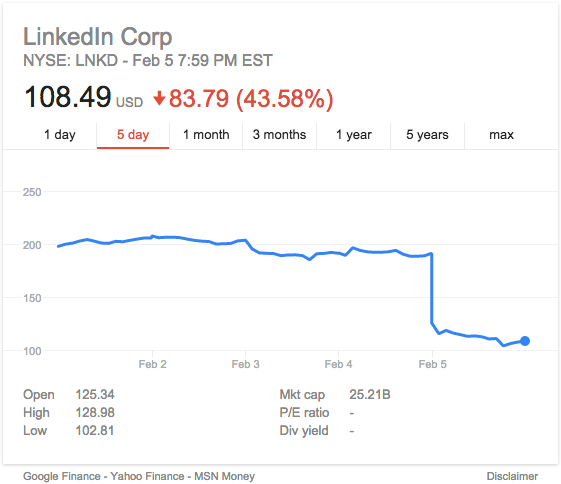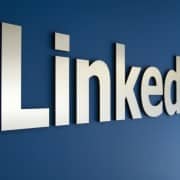A Few Ways LinkedIn Can Turn Itself Around
This article originally appeared on CoreyPadveen.com.
There are a few important changes LinkedIn needs to make in order to save itself from a disastrous fate.
If you happened to catch a glimpse of LinkedIn’s stock price over the last week or so, you might have noticed a straight line downwards on Friday February 5th. That wasn’t a glitch; LinkedIn’s stock price has fallen by over 40% (at the time of writing) since it announced lower-than-expected earnings and lowered projections for the coming year. Investors are losing their patience.

Despite having a great core product (which LinkedIn very much still does) many of the efforts of the professional network to expand have not yielded strong results. In fact, in a lot of respects, those expansion efforts have rather resulted in an almost ‘worst case scenario’ outcome.
This is not to say that LinkedIn has missed the mark every time it has done something; the acquisition of SlideShare in 2012, for example, was a brilliant move and continues to be among its best. But some of the more universal oversights have cost the network dearly, and there are a few pain points that need to be addressed as soon as possible in order to end the slide into penny stock status (though that’s still a long way off – we hope).
Spamalot Central
Facebook is consistently working on its algorithm in order to ensure that the content you see is what is most relevant to you. The result has been quarter-over-quarter growth in average session time, engagement per post, engagement per user, and more metrics that have come into existence since the advent of social media in the world of marketing.
LinkedIn has taken a slightly different approach.
In order to encourage engagement among its users, InMail exists (which guarantees a user will see the message). Of course, users pay for that privilege, but is accommodating the users who pay for mass (spam) messages like that really worth the detriment that does on the user experience as a whole?
How often do you receive unsolicited messages on LinkedIn offering to sell you traffic, invest in a business opportunity, or, in some cases, enlarge or enhance something? In the last month alone, I’ve been included on over a dozen chain-style message threads (another issue) from users (and including users) with whom I’ve never connected. I pay close attention to who I allow into my professional circle, but all that seems to factor into is my feed content, and has no influence on what kind of trash I’m sent from peddling affiliates.
A better spam filtration system needs to be put in place by LinkedIn and it needs to be put in place fast. More and more users (as exhibited by time on site and people I’ve spoken to) are using LinkedIn for little more than a place to host a resume and highlight some skills, rather than a network where actual business can get done. These filters don’t need to be all that complicated either for them to work (and improve the experience).
First, these kinds of promotional messages (and chain messages) should be restricted to second or third points of contact. Introductions (with character limits or standard content set by LinkedIn) should be the ONLY content that non-connections are allowed to send at the outset. If someone send me something along the lines of, “Thanks for connecting, I look forward to talking to you a little bit more about how we might be able to work together!” I’ll be significantly more likely to look through his or her profile, see what it is they do and, if I see potential, engage with the user and open up a professional dialogue.
I wonder what kind of horrific return these affiliates and marketers see when they purchase InMail packages and generate nothing. That might be a nice short term gain for the network, but as we have seen with this year’s earnings reports, it’s not a solution.
Improved Ad Dashboards
Advertising is any social network’s (even a professional one’s) bread and butter. So, as we’ve seen with Facebook – the shining example of social advertising that marketers love – constant improvements should be made to a dashboard in order to make it simpler, more effective and more evolved. This is an area where LinkedIn has really struggled.
As someone who has been involved in social advertising for years now, it is not hard to tell which network (of Facebook, Twitter and LinkedIn) has seen the slowest evolution in its ads platform. As Facebook and Twitter have introduced new capabilities and made the management of campaigns and creative much more efficient, LinkedIn has done little to evolve its dashboard.
It has certain undergone some aesthetic changes, but ad campaigns function in an archaic fashion. It is almost as if marketers are publishing magazine ads and hoping that they work. Why do I say this? Well, ads can be created…but that’s about it. Editing is a nightmare (if not entirely non-existent) and as you create varieties of your creative, your campaign become overwhelmingly populated with different variations. For a network that is built on professionalism, the ads dashboard is far too disorganized.
A simpler, more tasteful segmentation, like that of Facebook’s setup (which modelled itself after Google) would make life much easier. Moreover, the ability to edit ads and feature proper creative to populate a link preview (as opposed to a tiny window with a fraction of what’s actually on the ad) would go a very long way in driving marketers to use LinkedIn ads more frequently.
Improved Ad Placements
And again with the ads.
Most marketers can agree that the age of the banner is dead. And yet, the right-hand side ad lives on. Granted it is a viable bit of real estate, and LinkedIn has done a better job than Facebook of optimizing the appearance of the RHS ad (instead of several ads scrolling, one appears in a noticeable box at a time) but for advertisers the value is in sharing content to a targeted user’s feed.
That can still be done on LinkedIn, but where both Facebook and Twitter have the network beat is in how to drive traffic from these ads. As noted above, the tiny image that populates a link is completely worthless. A large, eye-catching piece of creative with a clear call-to-action and a different visual structure than a regular post or update is what makes an ad worth the marketer’s budget. LinkedIn needs to make changes to how creative we can get with those ads.
There is no denying the viability of the audience on LinkedIn. Barring those users that are simply sharing spam (I’ll get to that again in a second) there is the most targeted group of people active on the network than any other social platform. So it would make sense that LinkedIn charges a little bit more than other networks for its ad space, but you’re paying five, ten even twenty times as much per click (trust me I’ve done the comparisons) for an ugly, boring ad that can’t be changed once you click ‘Start’.
Ads need to be more visually stimulating if marketers are to see results from them, and their placements need to be more apparent in the timeline than simply allowing users to create Sponsored Updates.
User Purge
LinkedIn has registered about 414 million users. Based on the content I mentioned above that floods my inbox, I wouldn’t flinch if you told me half of those were spam.
OK – maybe not half. But you get my point.
It’s time for LinkedIn to clean up its network. Hitting that critical mass is exciting, and it means charging more for advertising, but as more bots and tactless affiliates join the network, the value of that ad space goes down. Now, the cat is out of the bag as far as how people are using the network. Several are using the online space to store a resume. Others are using it to share content and find a new job. Recruiters are using it to find those users. And so, so, SO many are using it to tell me about an amazing business opportunity that I need to act on or sell me traffic.
To rebound from this devastating hit, LinkedIn may need to sacrifice a huge portion of its user base. That might seem counterintuitive, but one theme that has been apparent in a lot of what LinkedIn has done has been short-term thinking. This is looking at the value to marketers in the long-run.
Conclusion
Nothing here is vastly complex. I’m not suggesting a paradigm shift in how the network functions or what it offers. These are existing models that simply need a tweak.
Of course, this won’t happen overnight. It will take time and it will take just as much (if not more) time to see the effects of this working. But I really do believe that in order for LinkedIn to survive this downward spiral, it needs to look towards simplification, rather than expansion.
As Wall Street begins to shake and the memories of 2000 start to creep back up in their minds, they are taking good hard looks at what is working and what is not. Right now, there is a lot about LinkedIn that scares them. But the potential is certainly there and the product is fantastic. Taking heed of a few of these suggestions might just help it get back into the good graces of the powers that be (and drive up active advertiser numbers as well).
What do you think LinkedIn needs to do to come out of this mess?






